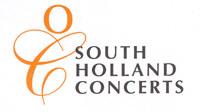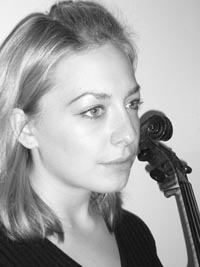Rebecca Jones (Viola)
Rebecca Jones graduated with distinction from the Royal
Northern Collage of Music winning various scholarships and prizes, and
has been successful in national and international competitions. She
has recently completed study at the Universität Mozarteum at Salzburg
where she was a pupil of Thomas Ribel, and has been in receipt of an
award from the Countess of Munster Musical Trust.
Rebecca plays on a viola bought by the Myra Hess Trust
and has particular interest in chamber music, performing with the Callino
Quartet in engagements at Prague and Budapest. The Callino Quartet has
also joined with the renowned Belcea Quartet in recent performance of
the Mendelssohn Octet. She has also performed as principal viola with
Camerata Salzburg.
Gretel Dowdeswell (Piano)
Last minute replacement for Abigail Richards
Programme
MÄRCHENBILDER (Fairy Tales) op.113 Robert
Schumann (1810-1856)
1. Nicht schnell
2. Lebhaft
3. Rasch
4. Langsam, mit melancholischem Ausdruck
Robert Schumann's life was increasingly permeated by ill
health. Towards the end of his life, his bouts of depression led to
schizophrenia and mental breakdown, eventually leading to his attempted
suicide. However, between these episodes of serious illness Schumann
penned some of his most exquisite works, many of these being chamber
pieces of great originality and charm such as these Märchenbilder
pieces for viola.
Occasionally heard with the accompaniment of strings,
and sometimes in an arrangement for cello, these miniatures are in every
way characteristic of this romantic composer's ability to evoke powerful
atmospheres and lasting impressions.
The whimsical and evocative opening melody of the first
piece stays in the listener's memory long after the work has finished.
The powerful and heavily accented second movement is followed
by a busy and dramatic toccata-like third movement - a real technical
tour-de-force for the viola!
The final movement, in which Schumann asks for an expression
of "slow melancholy", invokes a dream-like world of uncanny
peace and tranquillity of almost Brahms-like quality. There is little
evidence of the mental turmoil of the composer's personal life here.
The work ends in quiet reflection.
For those acquainted with Schumann's popular song cycles
of his earlier years, the style of this music may strike a familiar
chord. The lines and textures, especially in the outer movements, allow
the viola to 'sing' with a richness and warmth of tone that is typical
of the composer and utterly irresistible.
VIOLA SONATA Rebecca Clarke (1886-1979)
Impetuoso - poco agitato
Vivace (scherzo)
Adagio - agitato - comodo quasi pastorale - quasi fantasia.
Rebecca Clarke was born in Harrow, England, and was a
highly respected viola player. She was a pupil of the great violist,
Lionel Tertis with whom she studied at the Royal College of Music. She
eventually became a member of the Queens Hall Orchestra - one of the
first female musicians to do so.
Clarke was encouraged in her composition by Stanford,
and in 1916 she moved to the United States to further her career as
a composer. This Sonata for viola dates from 1919 and is a valuable
inclusion in the soloist's repertoire, now being fairly frequently performed
in recitals for the instrument. It has three movements, the final of
which is in many contrasted sections. The musical language of Debussy
is a strong influence in this work, containing as it does some lush
textures and bold modernistic harmonies.
The Sonata was first performed at the Berkshire music
festival and was written at the height of her career as a composer.
Clarke produced a great many early songs (many unpublished), and in
the 1920s she also wrote a small number of finely-crafted chamber works,
many featuring the viola. However, she practically ceased composition
in the 1940s, partly from a chronic form of depression, and partly in
order to devote herself to family life.
INTERVAL
LACHRYMAE Benjamin Britten
(Reflections on a song by John Dowland) (1913-1976)
Britten is a composer who frequently wrote with particular
performers in mind, and almost entirely for performance on specific
occasions. He claimed not to write for posterity but "to please
people today and to let the future look after itself." The future
has given its verdict on his music. The sheer variety and originality
of his numerous compositions have universally delighted performers and
listeners alike.
The artist for whom Britten wrote his Lachrymae for viola
in 1950 was the renowned viola soloist William Primrose, a former section
leader in Toscanini's NBC Orchestra. The viola and piano were both instruments
that Britten played himself, and the work incorporates many advanced
techniques for the soloist. A later arrangement with string accompaniment
was published in 1976.
This unusual piece is basically a series of variations
based on the song If my Complaints could Passions Move by the sixteenth-century
English composer John Dowland. It is only towards the end of this remarkable
piece that we hear the full original theme in Dowland's own harmonisation.
However, this was not the only time that Britten was moved
to write works based upon Dowland's music. In 1964, the famous lutenist
and guitarist Julian Bream gave the first performance of Britten's Nocturnal
after John Dowland built on the theme of the earlier composer's song
Come Heavy Sleep.
SONATA IN F MINOR OP 120 Johannes Brahms
(1833-1897)
Allegro appassionato
Andante un poco adagio
Allegretto grazioso
Vivace
Brahms originally wrote two late sonatas for clarinet
and piano. The first, this Sonata in F minor, we hear tonight in a version
for viola. Both clarinet sonatas were first performed in 1894 by Brahms'
friend, the virtuoso Richard Mühlfeld, with the composer at the
piano.
Following this first performance, Brahms is known to have
corresponded with another close friend, the famous violinist Joachin,
suggesting that, with minimal alteration, the Sonatas would be equally
suitable for performance on the viola. Today both Sonatas are given
as many recordings and performances on this instrument as on the clarinet.
With only a very few octave changes to the solo part, Brahms has achieved
a surprisingly similar range of musical colour and texture with both
instruments.
The piano throughout is a real 'duo' partner to the viola
- not a mere accompanist. As in Schumann's Märchenbilder (played
at the start of our concert) the opening viola melody in the first movement
Allegro appassionato is a beautiful romantic theme around which much
of this movement's later music is based.
The long viola melody which opens the second movement,Andante,
is a simple tune delightfully decorated, which acts as a prelude to
one of the loveliest extended instrumental 'songs' that Brahms ever
wrote.
By contrast, the third movement, Allegretto, is a lively
and spirited Viennese waltz, totally relaxed and of great charm.
The finale movement, Vivace, is a fast Rondo. In spite
of the Sonata's minor key, this movement's engaging passage work for
both instruments is breathtaking and it brings this joyful and colourful
work to a fitting and satisfying end.

